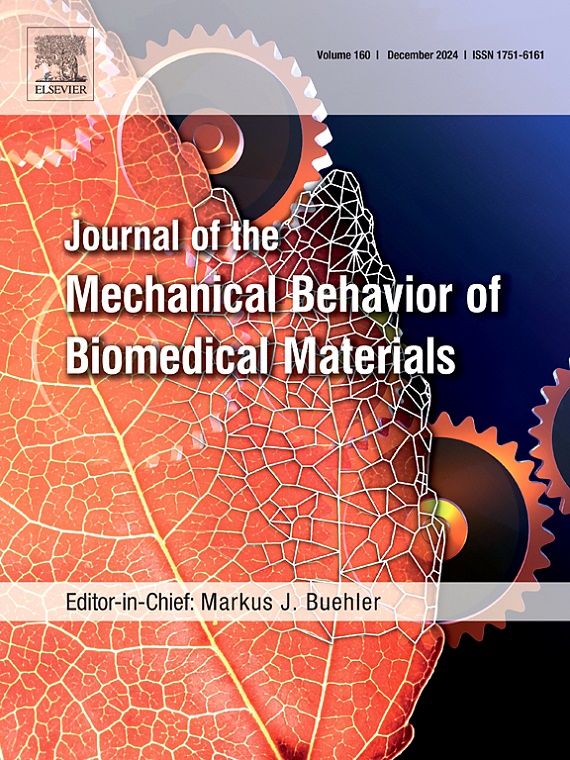缝合和囟门形态变异对婴儿颅脑损伤生物力学的影响
IF 3.5
2区 医学
Q2 ENGINEERING, BIOMEDICAL
Journal of the Mechanical Behavior of Biomedical Materials
Pub Date : 2025-07-24
DOI:10.1016/j.jmbbm.2025.107140
引用次数: 0
摘要
与成人相比,婴儿头部在材料特性和结构组成上都表现出显著差异,但关于婴儿头部生物力学的研究却很少。缝合线和囟门作为婴儿颅骨的整体软组织结构,在发育过程中允许灵活性和适应头部生长。然而,它们对婴儿头部对外力反应的影响仍未得到充分研究,这阻碍了婴儿交通安全措施、儿科头部损伤诊断和疑似虐待性头部创伤案件的法医评估的进步。为了弥补这一研究空白,我们旨在通过有限元模拟研究缝合和囟门形态对撞击下婴儿头部生物力学响应的影响。为此,我们首先开发了一种自动算法,用于生成具有可变缝线和囟门形态的有限元模型,以适应不同缝线和囟门形状的形态特征。系统地研究了这些变化的生物力学影响,包括冲击加速度曲线和颅骨骨折模式。此外,我们还研究了副缝线的作用,这是生物力学研究中一个经常被忽视的关键因素。结果表明,缝合和囟门形态的变化显著影响婴儿头部的生物力学。特别是,骨折更有可能沿着顶骨的附属缝合线传播,导致线状颅骨骨折。总之,本研究提供了对婴儿缝合线和囟门冲击载荷的全面理解,强调了儿科医生、生物力学研究人员和法医专家在评估儿童头部损伤时考虑缝合线和囟门形态的重要性。本文章由计算机程序翻译,如有差异,请以英文原文为准。

Influence of suture and fontanelle morphological variabilities on infant head injury biomechanics
Compared to adults, the infant head exhibits significant differences in both material properties and structural composition, yet far fewer studies exist on infant head biomechanics. Sutures and fontanelles, as integral soft tissue structures of the infant skull, allow flexibility and accommodate head growth during development. However, their influence on infant head responses to external forces remains inadequately studied, which hinders the advancement of infant traffic safety measures, pediatric head injury diagnosis, and forensic assessments in cases of suspected abusive head trauma. Addressing this research gap, we aim to study the influence of suture and fontanelle morphology on infant head biomechanical response under impact using finite element (FE) simulation. For this, we first developed an automated algorithm for generating FE models with variable suture and fontanelle morphologies, tailored to the morphological characteristics of different suture and fontanelle shapes. The biomechanical influences of these variations were systematically investigated, including the impact acceleration curves and the skull fracture patterns. Furthermore, we investigated the role of accessory sutures, a critical factor but often-overlooked in biomechanics research. The results show that variations in suture and fontanelle morphology significantly influence the biomechanics of the infant head. In particular, fractures were more likely to propagate along accessory sutures in the parietal bone, leading to linear skull fractures. In summary, this study offers a comprehensive understanding of the impact loading of infant sutures and fontanelles, highlighting the importance of considering the suture and fontanelle morphologies when assessing pediatric head injuries for pediatricians, biomechanics researchers, and forensic experts.
求助全文
通过发布文献求助,成功后即可免费获取论文全文。
去求助
来源期刊

Journal of the Mechanical Behavior of Biomedical Materials
工程技术-材料科学:生物材料
CiteScore
7.20
自引率
7.70%
发文量
505
审稿时长
46 days
期刊介绍:
The Journal of the Mechanical Behavior of Biomedical Materials is concerned with the mechanical deformation, damage and failure under applied forces, of biological material (at the tissue, cellular and molecular levels) and of biomaterials, i.e. those materials which are designed to mimic or replace biological materials.
The primary focus of the journal is the synthesis of materials science, biology, and medical and dental science. Reports of fundamental scientific investigations are welcome, as are articles concerned with the practical application of materials in medical devices. Both experimental and theoretical work is of interest; theoretical papers will normally include comparison of predictions with experimental data, though we recognize that this may not always be appropriate. The journal also publishes technical notes concerned with emerging experimental or theoretical techniques, letters to the editor and, by invitation, review articles and papers describing existing techniques for the benefit of an interdisciplinary readership.
 求助内容:
求助内容: 应助结果提醒方式:
应助结果提醒方式:


